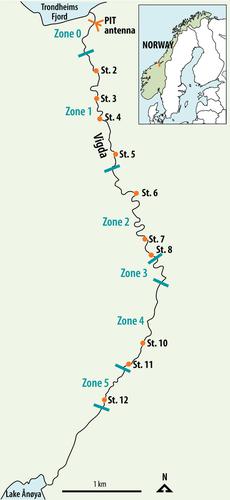当前位置:
X-MOL 学术
›
Ecol. Evol.
›
论文详情
Our official English website, www.x-mol.net, welcomes your feedback! (Note: you will need to create a separate account there.)
Considering sampling bias in close‐kin mark–recapture abundance estimates of Atlantic salmon
Ecology and Evolution ( IF 2.6 ) Pub Date : 2021-04-06 , DOI: 10.1002/ece3.7279 Sebastian Wacker 1 , Hans J. Skaug 2 , Torbjørn Forseth 1 , Øyvind Solem 1 , Eva M. Ulvan 1 , Peder Fiske 1 , Sten Karlsson 1
Ecology and Evolution ( IF 2.6 ) Pub Date : 2021-04-06 , DOI: 10.1002/ece3.7279 Sebastian Wacker 1 , Hans J. Skaug 2 , Torbjørn Forseth 1 , Øyvind Solem 1 , Eva M. Ulvan 1 , Peder Fiske 1 , Sten Karlsson 1
Affiliation

|
Genetic methods for the estimation of population size can be powerful alternatives to conventional methods. Close‐kin mark–recapture (CKMR) is based on the principles of conventional mark–recapture, but instead of being physically marked, individuals are marked through their close kin. The aim of this study was to evaluate the potential of CKMR for the estimation of spawner abundance in Atlantic salmon and how age, sex, spatial, and temporal sampling bias may affect CKMR estimates. Spawner abundance in a wild population was estimated from genetic samples of adults returning in 2018 and of their potential offspring collected in 2019. Adult samples were obtained in two ways. First, adults were sampled and released alive in the breeding habitat during spawning surveys. Second, genetic samples were collected from out‐migrating smolts PIT‐tagged in 2017 and registered when returning as adults in 2018. CKMR estimates based on adult samples collected during spawning surveys were somewhat higher than conventional counts. Uncertainty was small (CV < 0.15), due to the detection of a high number of parent–offspring pairs. Sampling of adults was age‐ and size‐biased and correction for those biases resulted in moderate changes in the CKMR estimate. Juvenile dispersal was limited, but spatially balanced sampling of adults rendered CKMR estimates robust to spatially biased sampling of juveniles. CKMR estimates based on returning PIT‐tagged adults were approximately twice as high as estimates based on samples collected during spawning surveys. We suggest that estimates based on PIT‐tagged fish reflect the total abundance of adults entering the river, while estimates based on samples collected during spawning surveys reflect the abundance of adults present in the breeding habitat at the time of spawning. Our study showed that CKMR can be used to estimate spawner abundance in Atlantic salmon, with a moderate sampling effort, but a carefully designed sampling regime is required.
中文翻译:

在大西洋鲑近亲标记捕获量估计中考虑采样偏差
估计种群数量的遗传方法可能是传统方法的有力替代方法。近亲标记夺回(CKMR)是基于常规标记夺回的原理,但不是通过肉体标记,而是通过近亲来标记个体。这项研究的目的是评估CKMR评估大西洋鲑鱼产卵量的潜力,以及年龄,性别,空间和时间采样偏差如何影响CKMR评估。根据2018年返回的成年人的遗传样本以及2019年收集的潜在后代的遗传样本,估计了野生种群中的Spanner丰度。成年样本的获取有两种方式。首先,在产卵调查期间对成年取样并在繁殖环境中进行活体释放。第二,遗传样品是从2017年标记为PIT的迁出的软体动物中收集的,并在2018年成年后归还时进行了注册。基于产卵调查期间收集的成年样本的CKMR估算值比常规计数高一些。不确定性很小(CV <0.15),这是由于检测到大量的父子对。对成年人的抽样有年龄和大小偏见,对这些偏见的校正导致CKMR估计值出现适度变化。少年的散布是有限的,但是成年人的空间平衡采样使CKMR估计值对少年的空间偏倚采样具有鲁棒性。基于返回的带有PIT标签的成年成年人的CKMR估算值大约是根据产卵调查收集的样本估算值的两倍。我们建议基于带PIT标签的鱼的估计值反映出成年河中成年鱼的总数量,而基于产卵调查期间收集的样本的估计值反映出产卵时繁殖栖息地中成年鱼的数量。我们的研究表明,CKMR可以用于估算大西洋鲑鱼的产卵量,并且需要适度的采样工作,但是需要精心设计的采样方案。
更新日期:2021-05-04
中文翻译:

在大西洋鲑近亲标记捕获量估计中考虑采样偏差
估计种群数量的遗传方法可能是传统方法的有力替代方法。近亲标记夺回(CKMR)是基于常规标记夺回的原理,但不是通过肉体标记,而是通过近亲来标记个体。这项研究的目的是评估CKMR评估大西洋鲑鱼产卵量的潜力,以及年龄,性别,空间和时间采样偏差如何影响CKMR评估。根据2018年返回的成年人的遗传样本以及2019年收集的潜在后代的遗传样本,估计了野生种群中的Spanner丰度。成年样本的获取有两种方式。首先,在产卵调查期间对成年取样并在繁殖环境中进行活体释放。第二,遗传样品是从2017年标记为PIT的迁出的软体动物中收集的,并在2018年成年后归还时进行了注册。基于产卵调查期间收集的成年样本的CKMR估算值比常规计数高一些。不确定性很小(CV <0.15),这是由于检测到大量的父子对。对成年人的抽样有年龄和大小偏见,对这些偏见的校正导致CKMR估计值出现适度变化。少年的散布是有限的,但是成年人的空间平衡采样使CKMR估计值对少年的空间偏倚采样具有鲁棒性。基于返回的带有PIT标签的成年成年人的CKMR估算值大约是根据产卵调查收集的样本估算值的两倍。我们建议基于带PIT标签的鱼的估计值反映出成年河中成年鱼的总数量,而基于产卵调查期间收集的样本的估计值反映出产卵时繁殖栖息地中成年鱼的数量。我们的研究表明,CKMR可以用于估算大西洋鲑鱼的产卵量,并且需要适度的采样工作,但是需要精心设计的采样方案。



























 京公网安备 11010802027423号
京公网安备 11010802027423号